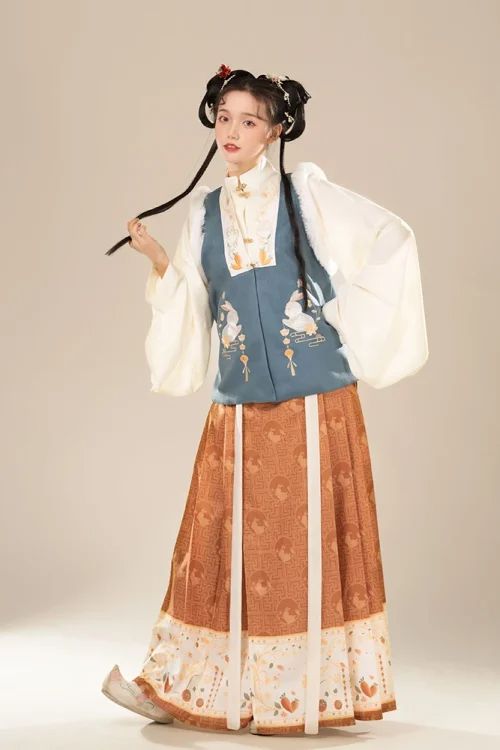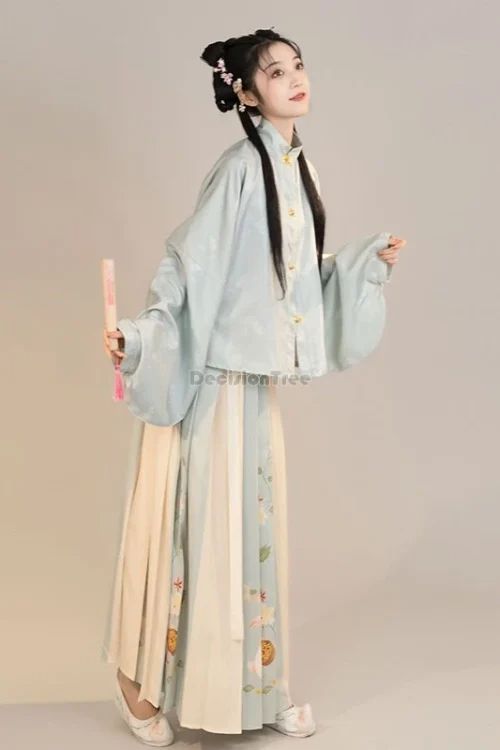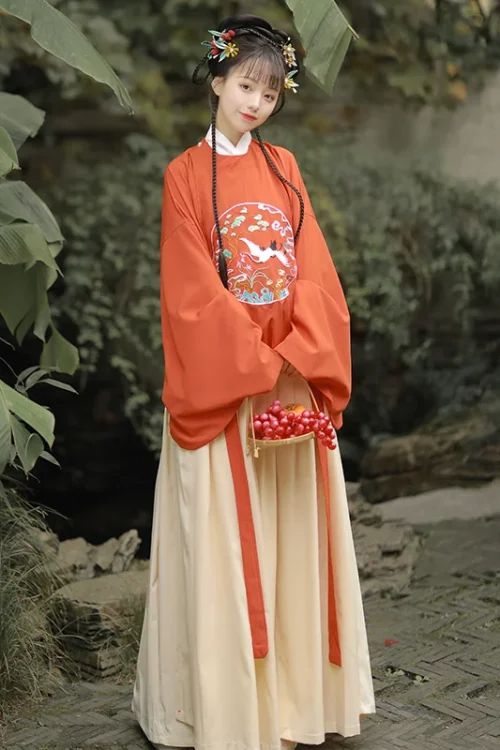Gender Expression and Identity in Ming Dynasty Hanfu
During the Ming Dynasty (1368-1644), Hanfu, the traditional Chinese clothing system, played a significant role in shaping gender identity and social norms. Hanfu was not merely a form of attire but a complex cultural expression that reflected the hierarchical and gendered society of the time.

Women’s Hanfu: Symbols of Modesty and Propriety
For women, Hanfu served as a symbol of modesty and propriety. The female Hanfu consisted of a long, flowing robe known as a ruqun, which was worn over a skirt or trousers. The ruqun was often adorned with intricate embroidery and decorative patterns, reflecting the wearer’s social status and marital status. Women were expected to dress modestly, covering their bodies and avoiding revealing clothing.
Men’s Hanfu: Varied and Expressive
In contrast, men’s Hanfu was more varied and expressive. The basic male Hanfu consisted of a long robe called a changpao, worn over trousers. However, men could also wear a variety of other garments, such as jackets, vests, and hats. The choice of fabric, color, and accessories allowed men to express their individuality and social standing.
Social Customs and Regulations
The gendered nature of Hanfu was reinforced by social customs and regulations. Women were expected to wear Hanfu in public, while men could choose to wear either Hanfu or Western-style clothing. This distinction reflected the different roles and expectations assigned to men and women in Ming society.
Gender Identity from a Young Age
Furthermore, Hanfu played a role in shaping gender identity from a young age. Children were dressed in Hanfu that reflected their gender, reinforcing the social norms and expectations associated with each sex. As children grew older, their Hanfu became more elaborate and formal, marking their transition into adulthood and their expected roles in society.
Sumptuary Laws and Social Order
The Ming Dynasty’s emphasis on gender roles and hierarchy was reflected in the strict regulations governing Hanfu. The government issued sumptuary laws that dictated the types of fabrics, colors, and accessories that people of different social classes could wear. These laws aimed to maintain social order and prevent people from dressing above their station.
Individual Expression within Norms
However, despite these regulations, Hanfu also allowed for some degree of individual expression. Within the confines of social norms, people could choose the colors, patterns, and accessories that best suited their tastes and personalities. This allowed for a certain level of creativity and self-expression within the rigid gendered framework of Ming society.
Conclusion
In conclusion, Ming Dynasty Hanfu was a powerful symbol of gender identity and social norms. The different styles and regulations associated with male and female Hanfu reflected the hierarchical and gendered nature of Ming society. While Hanfu reinforced social expectations, it also allowed for some degree of individual expression, shaping the identities of both men and women during this period.
The Evolution of Hanfu as a Reflection of Gender Roles
During the Ming Dynasty, Hanfu, the traditional Chinese clothing, played a significant role in shaping gender roles and identities. The intricate designs and elaborate fabrics of Hanfu reflected the social hierarchy and cultural norms of the time.

Women’s Hanfu: Modesty and Virtue
For women, Hanfu served as a symbol of modesty and virtue. The long, flowing robes concealed their bodies, adhering to Confucian ideals of propriety. The use of bright colors and intricate embroidery, however, hinted at their beauty and femininity. Women’s Hanfu often featured wide sleeves, allowing for graceful movements and emphasizing their delicate nature.
Men’s Hanfu: Power and Authority
In contrast, men’s Hanfu exuded power and authority. The shorter robes and narrower sleeves facilitated mobility and symbolized their active roles in society. The use of darker colors and simpler designs conveyed a sense of seriousness and masculinity. Men’s Hanfu also included accessories such as belts and hats, which denoted their social status and official positions.
Hairstyles and Gendered Expectations
The differentiation in Hanfu between genders extended beyond aesthetics. Women were expected to wear their hair in elaborate buns or braids, adorned with hairpins and ornaments. Men, on the other hand, typically wore their hair short or tied back in a simple ponytail. These hairstyles reinforced the gendered expectations of the time.
The Cross-Collar Robe
The Ming Dynasty witnessed the emergence of a new type of Hanfu known as the “cross-collar robe.” This robe, worn by both men and women, featured a unique collar that crossed over the chest. While the cross-collar robe initially symbolized equality, it gradually became associated with women’s fashion. This shift reflected the increasing emphasis on gender segregation and the confinement of women to domestic roles.
Evolving Gender Dynamics
The evolution of Hanfu during the Ming Dynasty mirrored the changing gender dynamics of the time. The distinct designs and styles of Hanfu reinforced the social hierarchy and cultural expectations for men and women. As society evolved, so too did the role of Hanfu in shaping gender identities and fashion.
Hanfu as a Symbol of Cultural Identity and Gender Expression
During the Ming Dynasty (1368-1644), Hanfu, the traditional clothing of the Han Chinese, played a significant role in shaping gender identity and social norms. The intricate designs and elaborate fabrics of Hanfu reflected the wearer’s social status, age, and gender.

Women’s Hanfu: Elegance and Grace
For women, Hanfu served as a symbol of modesty and virtue. The garments were typically loose-fitting and covered the body from neck to ankle. The sleeves were often wide and flowing, adding an air of elegance and grace. Women’s Hanfu also featured intricate embroidery and decorative patterns, which varied depending on the wearer’s social rank.
Men’s Hanfu: Practicality and Tailoring
In contrast, men’s Hanfu was more tailored and practical. The garments were often made from coarser fabrics and featured simpler designs. The sleeves were narrower and shorter, allowing for greater freedom of movement. Men’s Hanfu also included a sash, which was used to secure the garment at the waist.
Reflection of Gender Roles
The differences in Hanfu design between men and women reflected the distinct gender roles and expectations of Ming society. Women were expected to be demure and reserved, while men were expected to be active and assertive. The clothing they wore reinforced these societal norms.
Individual Expression within Prescribed Roles
However, Hanfu also allowed for some degree of individual expression. Within the prescribed gender roles, individuals could choose from a variety of fabrics, colors, and patterns to create a unique and personalized style. This allowed for a subtle form of self-expression within the confines of societal expectations.
Cultural Resurgence and Identity
Furthermore, Hanfu played a crucial role in cultural identity. During the Ming Dynasty, China experienced a resurgence of national pride and cultural awareness. Hanfu became a symbol of this renewed sense of identity, representing the rich cultural heritage of the Han Chinese people.
Conclusion
In conclusion, Ming Dynasty Hanfu was not merely a form of clothing but a powerful symbol of gender identity and cultural expression. The intricate designs and elaborate fabrics reflected the wearer’s social status, age, and gender, reinforcing societal norms. However, within these prescribed roles, individuals could find ways to express their individuality through the choices they made in their Hanfu. Ultimately, Hanfu served as a tangible connection to the rich cultural heritage of the Han Chinese people.
